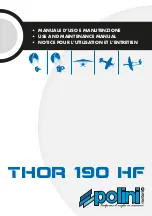
GS R/C
DLA ENGINE OPERATING-INSTRUCTION
MANUAL
04-21-21
Copyrighted Material
Owner’s Manual
All Rights Reserved
03180-10000
Page - 23
DLA 32, 58, 64, 64-I2, 116, 116-I2 & 128cc, 180c, 232cc
Rev. A.05.15
The sensor timing is set at the factory to ~ 30
O
before TDC, and you should not have to be reset it.
If you do not have the proper tools and experience with setting the timing, you may be better off
leaving it alone
. Never-the-less, depending upon several factors including: altitude, temperature,
ultimate tuning for specific application such as racing, you may want to adjust the timing. Be sure
to check the sensor screws to be sure they are tight and mark the sensor edges on the crankcase
with a felt pen or scribe for reference before proceeding. This manual will offer only limited
timing information and if you feel you need to adjust the time, please contact GS R/C and we may
be able to provide more definitive information, depending on your situation.
The sensor timing is set in degrees
(
O
)
of crankshaft rotation
(counter clock-wise),
before
T
op-
D
ead-
C
enter (TDC). TDC is when the piston is at the furthest travel toward the top of the cylinder. A
magnet, which is pressed into the prop-hub, follows the top of the piston and will typically align
with a “landmark” on the crankcase at TDC. As the magnet passes under the sensor, it stimulates
the sensor and sensor generates an electrical pulse which the CDI uses to create a spark in the
sparkplug. The sensor’s electric pulse is represented in the diagram below. The pulse can be
several degrees wide; so, it is important to set the timing on the negative edge of the pulse which is
position where the magnet is “leaving” the sensor.
The timing pulse occurs on the “white-wire”, where the Red = Power, and the Black = Ground-
return. Rotate the prop-hub to the position where the piston is at TDC.
The 116cc, In-line and 128cc QUAD engines have two (2) sensors and two (2) CDI’s and each must
be set separately, see table below.
The In-line and the QUAD sensor settings are 180
O
apart and
each sensor is set specifically for the cylinder or cylinder bank that particular sensor is controlling
.
Engine Disp.
Timing before TDC
1
st
Cylinder of Bank
2
nd
Cylinder or Bank
32cc
28 - 32
O
(30
O
Typ)
58cc
28 - 32
O
(30
O
Typ)
64cc
28 - 32
O
(30
O
Typ)
116cc Twin
28 - 32
O
(30
O
Typ)
116cc IL
30
O
Typ
28-29
O
128cc QUAD
30
O
Typ
28-29
O
Note: Increasing the angle is said to be “
Advancing
” the time and decreasing the angle is said to
be “
Retarding
” the timing.
.
With the In-Line and the QUAD engines, it is often advisable to set the 2
nd
cylinder (rear) or 2
nd
cylinder bank, 1-3
O
retarded with respect to the 1
st
cylinder/bank
. This is done to help keep the 2
nd
cylinder/bank cool, as these cylinders are in the “hot-air shadow” of the front cylinder/bank.
Special consideration for cooling the 2
nd
cylinder/bank (rear) should always be addressed. (See
Cowl Ducting and Air Flow below.)
where “
x
” is proportional to the ignition battery voltage
+ x V
~ 0 VDC
The timing is set on the negative
edge of the pulse, where the
magnet disengages the sensor
Where the magnet 1
st
stimulates the sensor
















































